Vermes
Advanced Member level 4


This device backups the power for home, a CO furnace and a pump for the solar installation.
The aim is to independent the emergency power from the electricity network.
Things needed:
- 2 photovoltaic panels 110W, 12V with a charge controller
- 2 accumulators 120Ah, 12V
- UPS Sinline800 (the power output is 520W, but the power is 24V)
It is possible to make a simple electronics, which would recognize the lack of 230V and would be controlled with a clock. A socket driver after eliminating the sockets and few elements responsible for the utility power and the cables soldering, gives the controller which short-circuit the output line to the ground. Firstly, the clock was used to turn the converter on in the morning and turn it off in the afternoon, when the Sun wasn't shining.
The microprocessor controller was programmed in Bascom on Attiny 2313.
The active state of the device is signalized by a short blink of WORK LED every 4s. The blinking is realized without the interruptions, and the delay is made on simple skips. Thanks to this, it is known that the main program loop is supervised at all times, not hanging and the conditional response is any driver features only a few milliseconds.
When the converter is being turned on, the WORK LED blinks every 0,5s – for Sinline it lasts about 8s, for PowerWare 4-5s. The end of the procedure is starting in the moment, when the tension on the converter output occurs. When there's no tension during 10s, the emergency mode turns on – the EMERGENCY LED is turning on and after 5s there is another attempt of start. When there's still lack of tension, the controller waits 15min. After that, there is another attempt and so on, until the effect. During this, only the EMERGENCY LED is blinking slowly 4s/4s. Exit the mode is possible only after turning the controller off or when none of the functions have to use the converter (e.g. the temperature outside dropped and the solar pump doesn't have to work anymore). When the converter is turned on properly, the WORK LED is lighting and every 4s extinguishes as a signal, that the main loop is being supervised.
The converter may be overloaded under some circumstances and it can stop automatically. Then all active transmitters are immediately turned off and the device enters into emergency mode. If it is restarted after 5s, everything returns to the state before the emergency. If not – look above.
Detection of the grid voltage 230V. When the tension disappears (or appears), the controller waits 4s (the EMERGENCY LED is blinking very quickly) from the tension state to stabilization. After that, a proper flag is set in program, needed to the UPS function working. The lack of tension is being signalized by by short blinking of EMERGENCY LED every 2s. 4s of delay is for preventing the converter for turning on/off by accident after a short pulse.
The emergency supply of the solar pump in case of lack of tension – connected with simultaneous outside temperature controlling. If the temperature is lower than 28 Celsius degrees in sunlight, the pump wouldn't turn on. This temperature is safe enough not to overheat the solar collectors in case of the lack of tension and the temperature. The WORK LED is also blinking 2 times every 4s, not once, as in another functions.
In the future, the state of accumulator charging will be checked and if it's fully charged, the pump will be working as if there's tension in the network (the balance will be in plus anyway).
The heating stove emergency power is a very important option, because when there isn't any current in winter, the heaters would be cold.
The flat lightning emergency power in chosen rooms (almost in whole house), one series of sockets (practically used only for mobile chargers and Christmas tree) and the entrance gate. When using energy-saving bulbs, the maximum load of the converter is about 380W (without the entrance gate), practically it is 100 to 200W.
The flat lightning emergency power at set hours. The clock controller was used in this function, so it wasn't necessary to make it in a program. The controller is equipped with many useful options. The clock turns the power on at evening hours (7 p.m. to 11 p.m.). If bad weather lasts too long, it can be switched into an “every second day” mode. Practically, after only 3 days of bad weather and using the emergency power by those 3 days, after the appearance of sunny weather, the accumulators were fully loaded by only 1,5 day. It's worth saying, that those days weren't without clouds at all. The medium current of loading was 3-4A.
Easy replacement of the converters. The power from the accumulators has to be winded to two sockets, the transmission of output plug 230V, the transmission of the controller plug DB9 and a switch on the side of the up controller.
Summarizing:
The device works without any problems. From the economical point of view, because of the photovoltaic panels, it's hard to say when it would be worthwhile. It's good when you need to save the solar pumps or the central heating stove.


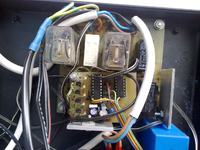
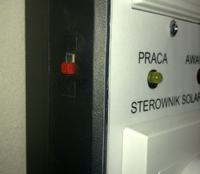


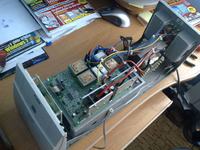

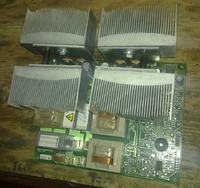

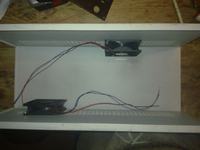


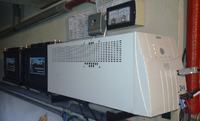
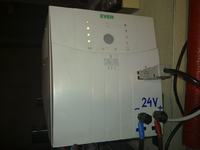
Link to original thread (+program code) – Awaryjne zasilanie mieszkania - ogniwa fotowoltaiczne.